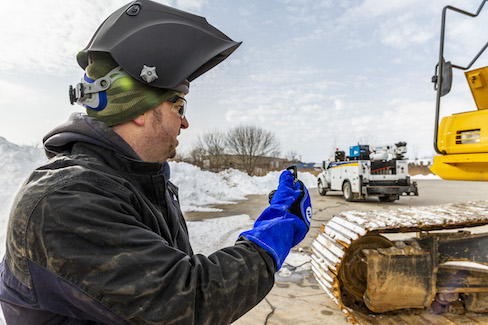Three Ways to Cut Field Welding Costs
Walking back and forth to a vehicle to tweak an engine-driven welder/generator’s control panel takes time. Remote control devices increase productivity by putting the ability to make changes in the palm of the operator’s hand.
Posted: November 18, 2020
WELDING TIPS COLUMN
BY BRIAN BELLILE
Whether the job involves new construction, emergency repairs or planned equipment maintenance, welding in the field involves peripheral activities that eat up time and money – walking back and forth to a truck to start or stop an engine-driven welder/generator or to tweak parameters, to name just two.
Manufacturers have begun using wireless communications to improve the efficiency of their power sources, developing remote control units similar to a passenger car’s battery-operated key fob. These solutions provide complete control of the machine from where the operator is working, an enormous gain in productivity and quality for at least three reasons.
- Constantly Idling the Welder/Generator
It’s common for operators to turn on their welder/generator when they get to the jobsite and let it run all day. While this seems convenient, there will likely be periods when there is no load being applied and the welder/generator doesn’t need to run.
When a machine runs all day, fuel costs can quickly add up. It also leads to more frequent downtime by increasing the need for maintenance. The average welder/generator is used about 30% of the time it’s running, meaning that up to 70% of the time it could be turned off.
Remote technology enables welders to easily turn the welder/generator on and off with the push of a button from where they’re working. Running the machine only when necessary saves up to $1,500 on fuel and maintenance per year compared to letting it idle while not in use.
Turning the machine off when it’s not being used also lowers jobsite noise levels. Other large machinery and heavy equipment often runs at the same time, so a welder/generator that’s running but not being used can make it harder to communicate with other workers or take calls from customers.
- Welding with Less-Than-Ideal Parameters
Days on the jobsite are varied, as are the jobs that must completed. Many welders must switch between MIG, stick and gouge processes or dial-in arc control.
On large jobsites where the power source is a long way from where the operator is working, it’s tempting to use the weld parameters that are already set to avoid walking back to the welder/generator to make changes. Staying put and making do with suboptimal parameters is more convenient, but can result in poor weld quality or rework.
Most remote controls have limited options for adjusting these parameters and processes at the point of use. You want one that provides full process and parameter control from where the work is being done on the jobsite.
Wireless Interface Control from Miller Electric Mfg., for example, enables the welder to switch between processes, adjust parameters, save preset programs, and turn the machine on and off from up to 350 feet away. The handheld control unit greatly improves quality by virtually eliminating the need to return to the truck to finetune weld parameters.
- Losing Productivity to Maintenance Requirements
Routine maintenance keeps equipment running smoothly, but involves downtime. Running a welder/generator more than necessary because it’s convenient can significantly increase service frequency. More frequent maintenance means more time and money spent, and more downtime.
Technologies that allow operators to remotely turn the machine on and off help extend the time between maintenance cycles and decrease wear and tear on the machine. In fact, turning the welder/generator off when it’s not being used can extend service intervals by up to two and a half times.






